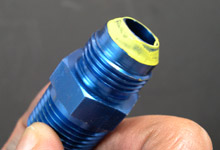|

Introduction
If you want to separate yourself and your car from the amateurs
you have to stop using cheap rubber hose and clamps to plumb
the vital fluids to your motor. That stuff works and gets
you by, but it is not classy and has major limitations in
durability and more importantly, safety. Most racing bodies,
like the NHRA, do not allow more than a six inch stretch of
rubber hose for things like fuel and oil lines. They mandate
that those fluids flow through hard-line or steel braided
line as those two materials are unlikely to burst, melt, or
be cut in the event of a mishap. That is why the top race
cars at the track have motors decked out in steel braided
line and those spiffy red and blue fittings - it is due to
safety and durability, not just because it looks cool. The
greatest benefit to AN (pronounce each letter) is in the sealing
capability. A connection between male and female AN flares
can handle tremendous pressure without leaking, making it
the right choice for oil, fuel or water. In this article we'll
give you the entire scoop on how to properly plumb your car
with AN hard and soft line.
Background
AN stands for "Air Force-Navy Aeronautical Standard"
and was an aviation fitting standard developed around WWII.
The fitting featured a 37 degree mating angle which provided
superior sealing compared to the common 45 degree fittings.
The fittings also utilized a higher class of
| 3 key facts about AN fittings. |
 Flare angle is 37°,
not 45°
Flare angle is 37°,
not 45° |
 Interchangeable
with JIC fittings Interchangeable
with JIC fittings |
 Divide AN # by 16 to get inches
Divide AN # by 16 to get inches |
|
thread quality. Eventually the AN
fittings saw widespread military use and a multiple manufacturers
began producing the fittings, leading to quality problems. The
Joint Industries Council (JIC), an industry organization, sought
to standardize the specifications on this type of fitting and
created the "JIC" fitting standard, a 37 degree fitting
with a slightly lower class of thread quality than the military
AN version. The SAE went on to adopt the JIC standard as well.
As a result JIC or SAE 37 degree fittings are perfectly interchangeable
with AN fittings, and while this may not be acceptable for military
aviation use, for automotive use there is no downside other
than perhaps mismatched color coordination as JIC fittings are
not available in the pretty anodize aluminum colors. However
this may be a worthy tradeoff considering the JIC fittings are
a fraction of the price of their true "AN" counterparts.
We mixed and matched in this article to show you their interchangeability.
Using AN
A half-dozen companies make AN fittings, hose, and line
and most all of it is interchangeable except for certain proprietary
"push on" type hoses and fittings. Always check
the manufacturers information before purchasing hose or hose
ends to make sure it is compatible. The AN side will always
be 37°, it is the hose side
that can vary depending on manufacturer designs. AN components
come in easy to understand sizes, all divisible by 16 for
easy conversion into fractions of one inch. For example, a
-8AN (dash 8 AN) hose is 8/16" inner diameter, or 1/2"
inch. AN is generally available in -4 to -12, and larger specialty
sizes.
When selecting AN you must determine if you need to use hard
line or soft line (generally Teflon, rubber, or special material
with a steel braided or other protective sheath) or a combination
of both. Hard line is not specific to AN, and this can be
aluminum or steel and can be sourced from any hardware supply
store. In other words 1/2" aluminum tubing is compatible
with -8AN fittings. Soft line is AN specific because it needs
to mate properly with the hose ends (as we'll show you later
in this article.) When selecting soft line be sure to use
hose material that is compatible with the fluid and pressure
you plan to run through it.
|
| |
 (Flaring the Hard Line)
(Flaring the Hard Line) |
|
|
|
|
|
|
| |
|
In This Article:
Pop the hood on any serious race car and you'll
likely see beautiful steel braided line and
colorful fittings. As nice as the look this
is all about functionality and safety. In this
article we cover how to properly source, flare
and assemble AN fittings and lines.
|
|
|
| |
|
| |

Despite being initially developed for
military aircraft use, AN has become a niche industry in the
automotive performance market. Companies like Russell, Earls,
and Aeroquip all produce a huge variety of fittings, hose
ends, and hose products to plumb any automotive fluid. |
| |
|
| |

It is important to distinguish the
difference between an AN/JIC flare and a typical compression
flare. While the look similar, the two hard lines have different
flare angles. Left is a 37° flare used for AN/JIC, while
right is 45°.
|
| |
|
| |

Using a 45° flared hardline on
an -AN fittings will result in leaks. The paint pattern here
shows incomplete contact between the male and female ends.
|
| |
|
| |

Here we see the result of a proper
seal between the AN fitting and 37 degree hard tube flare.
This seal will not leak and requires no sealant or Teflon
tape to work.
|
|
|